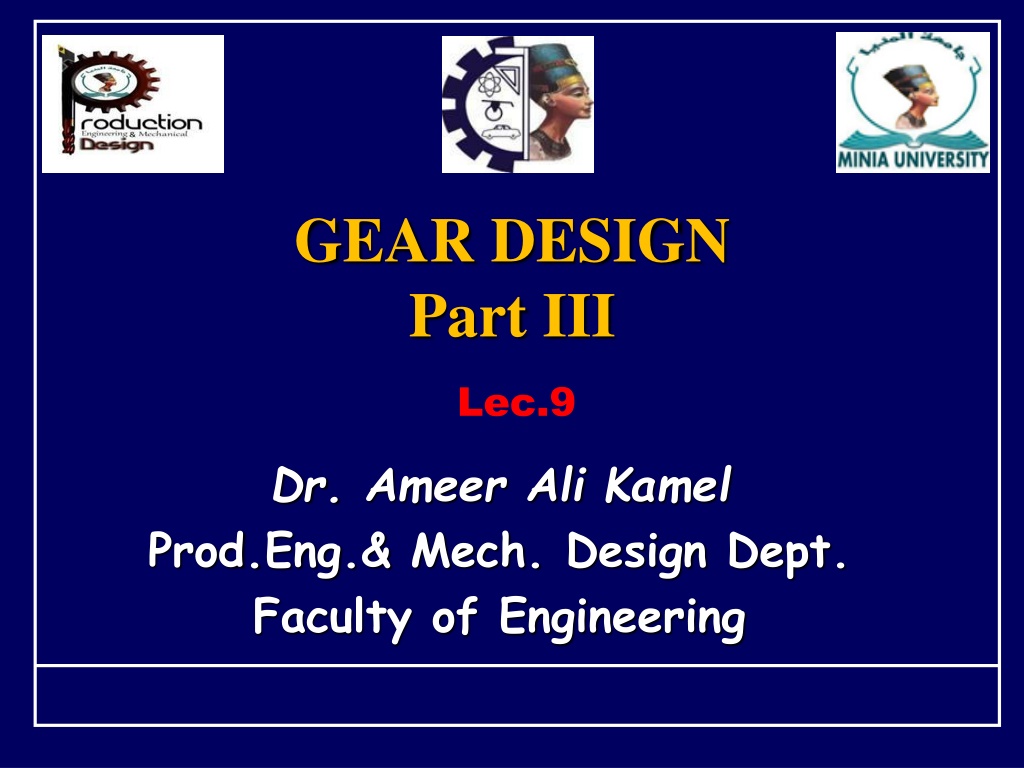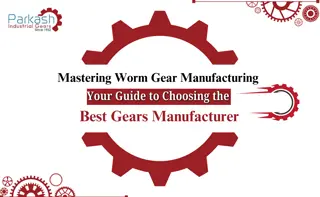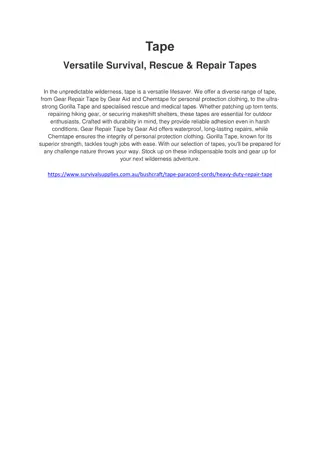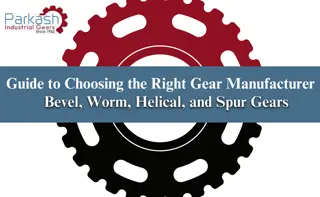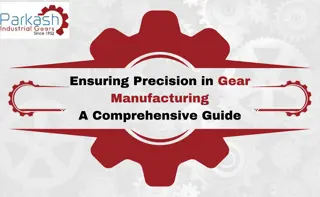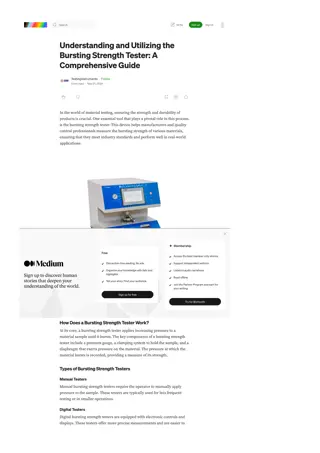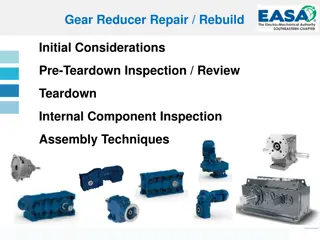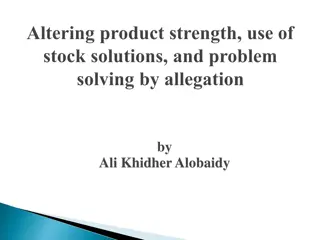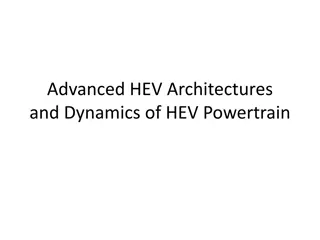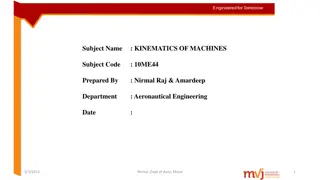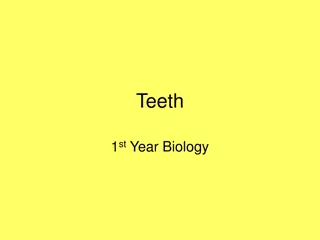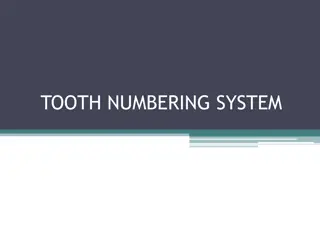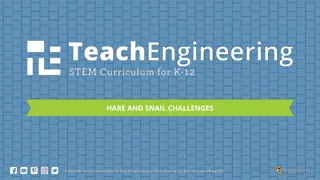Understanding Strength and Design of Gear Teeth
Exploring the strength and design aspects of gear teeth, this lecture covers topics such as load distribution, bending stress, form factor, number of teeth variations, gear force components, torque considerations, and the Lewis equation for gear design. The content provides insights into key factors affecting gear performance.
Download Presentation

Please find below an Image/Link to download the presentation.
The content on the website is provided AS IS for your information and personal use only. It may not be sold, licensed, or shared on other websites without obtaining consent from the author. Download presentation by click this link. If you encounter any issues during the download, it is possible that the publisher has removed the file from their server.
E N D
Presentation Transcript
GEAR DESIGN Part III Lec.9 Dr. Ameer Ali Kamel Prod.Eng.& Mech. Design Dept. Faculty of Engineering
STRENGTH OF GEAR TEETH Wn Wr 1. At the beginning of action between a pair of gear teeth, the flank of the driver tooth makes contact with the tip of the driven. W h A A t 2. The total load Wnis assumed to be carried by one tooth. 3. If the total load tangential component stress at the base of section). Wn W is produces the tooth resolved. The bending (weakest Design39- Spur Gear Animation 2
4. The radial component Wr because of its neglected small value. 5. The load is assumed to be uniform acroos the the the gear. Wn can be neglected Wr W h distributed face of A A t The produced normal stress due to bending can be determined from the following equation. b Mb Y b= = I 3
Where, t 3 bt = = Mb W h Y = = I = 2 12 Therefore, 6 W h = = b 2 bt and, 2 2 t t = = = = W b b P b b c 6 h hP 6 c 2 t The dimensionless ratio This ratio can be found in the following table. is called the form factor. hP 6 c 4
NUMBER OF TEETH, 12 13 14 15 16 17 18 19 20 21 23 25 27 30 34 38 43 50 60 14.5 FULL-DEPTH INVOLUTE 0.067 0.071 0.075 0.078 0.081 0.084 0.086 0.088 0.090 0.092 0.094 0.097 0.099 0.101 0.104 0.106 0.108 0.110 0.113 20 FULL-DEPTH INVOLUTE 0.078 0.083 0.088 0.092 0.094 0.096 0.098 0.100 0.102 0.104 0.106 0.108 0.111 0.114 0.118 0.122 0.126 0.130 0.134 20 STUB INVOLUTE 0.099 0.103 0.108 0.111 0.115 0.117 0.120 0.123 0.125 0.127 0.130 0.133 0.136 0.139 0.142 0.145 0.147 0.151 0.154 20 0.090 0.102 0.125 30 0.101 0.114 0.139 5
The horizontal (tangential) gear force component W can be considered transmitted force F . Therefore, substituting F for W and y for the form ratio. i.e., bP F b = = For ordinary design conditions, the gear width b is limited to a maximum value of 4-times the circular pitch Pc . i.e., P k b = = to be equal to the y c k 4 = = 4 P c c Therefore, 2 = = = = F bP y P ky b c b c 2 2 = = F kym b Torque = = and , F Pitch radius 6
REMARKS (A) If "D" is known, the following form of Lewis equation can be used: k . y . m Where, b(all): the allowable normal stress. K =4 M . 2 F = = The equation gives a numerical allowable value for the term (l/m2y). The value of the module can be determined after knowing the value of the number of teeth Z and the value of y (from the above table) 2 1 2 b ( all ) = = F t D 7
It is important to notice that the number of teeth of the pinion is assumed to be equal or more than 15 tooth. (B) If D" is unknown, then the following form of Lewis equation can be used: 2 3 b = = M . t m k . . . y . Z 2 where, b is the allowable stress. Mt = the transmitted torque. K = 4 Z = Number of teeth on the weaker gear. 8
NOTE 1. Minimum number of teeth = 15 2. economical design. Possible smallest Module means most 3. In general (if the diameters are known) design can be for largest number of teeth. 4. If the diameters are unknown, design can be for smallest pitch diameters. 9
ALLOWABLE TOOTH STRESSES If o is endurance limit of the gear material, V is the linear velocity of the pitch line velocity, then the allowable stress can be determined from the relations that given in the following Table. Allowable stress Linear Velocity 3 o = = V V < 10 m/s 3 V b ( all ) + + . 5 6 o = = 10 20 m/s 5 . 6 b ( all ) + + 6 o = = > 20 m/s 6 V b ( all ) + + 10
Values of the Endurance Limit The value of the endurance limit is the stress at a number of repeated cycles of 107. However, there are some values of the most common materials in the following table. ENDURANCE LIMIT MATERIAL ( o) N/mm2 55 83 70 - 350 1. Cast iron 1.Bronze 2.Carbon steel In general, the endurance limit can be taken as one third of the ultimate strength of the material. 1 = = o u 3 11
Design based on Weaker Gear As design based on the product 0y, therefore, the weaker gear is that with smaller value for this product. If the wheel material, therefore, the pinion is weaker. and pinion of the same 12
DYNAMIC TOOTH LOAD Sources follows: of dynamic load can be summarized as 1. Inaccuracy of tooth profiles. 2. Inaccuracy of tooth spaces. 3. Misalignment in mounting. 4. Tooth deflection under load that tends to velocity changes. 5. Misalignment in mounting. 13
The dynamic load Fd can be determined from the following equation (Buckingham equation). + + 21 V bC ( + + F + + ) = = + + Fd F 21 V bC F Fd: Dynamic load, N V : Pitch Linear Velocity, m/s B : Face width, m F : (Gear torque/ Pitch radius of gear) C : Constant in N/m 14
Deformation Factor C in kN/m Materials Tooth Error (mm) Involute Tooth form Pinion Gear 0.01 0.02 0.04 0.06 0.08 C.I. St. St. C.I. St. St. C.I. St. St. C.I. C.I. St. C.I. C.I. St. C.I. C.I. St. 14.50 14.50 14.50 55 76 110 57 79 114 59 81 119 110 152 220 114 158 228 118 162 238 220 304 440 228 316 456 236 324 476 330 456 660 342 474 684 354 486 714 440 608 880 456 632 912 472 648 952 200full depth 200full depth 200full depth 200 stub 200 stub 200 stub 15
Relation between tooth profile error in mm and the change in linear velocity. 0.16 Permissible Error,mm 0.12 0.08 0.04 0.00 0 10 20 30 40 50 Pitch Line Velocity, m/s 16
SOLVED PROBLEM A pair of mating spur gears has 14.5 full-depth teeth of 10 module. The pitch diameter of the smallest gear is 160 mm. If the transmission ratio is 3 to 2, Calculate: (a) Number of teeth for each gear. (b) Addendum. (c ) Whole depth. (d) Clearance. (e) Outside diameters. (f) Root diameters. (g) Dedendum. (h) Base circle diameters (i) Check for interference, 17
SOLUTION (a) Number of teeth for each gear. (b) Addendum. (c ) Whole depth. (d) Clearance. (e) Outside diameters. (a) Dp=160 mm Dg = 160 x(3/2) = 240 mm, Zp=160/10 = 16 teeth, Zg= 240/10= 24 teeth. (b) addendum = m = 10 mm (C) Whole depth = 2.157m = 2.157x10 = 21.57 mm (d) Clearance = 0.157 m = 0.157 x 10 = 1.57 mm (e) Outside diameter = pitch diameter + (2 x addendum) Outside diameter of pinion = 160 + 2 x 10 = 180 mm Outside diameter of gear = 240 +2x10= 260 mm 18
(f) Root diameters. (g) Dedendum. (h) Base circle diameters (i) Check for interference, (f) Root diameter = outside - 2 whole depth Root diameter of pinion = 180 -2 x 21.57 = 136.86 mm Root diameter of gear = 260 -2 x 21.57 = 216.86 mm (g) Dedendum = 1.157 m = 1.157 x 10 = 11.57 mm (h) Radius of base circle = pitch radius x cos 14.5 For pinion: Rb = (160/2) x cos 14.5 = 77.45 mm i.e. Diameter of base circle = 154.90 mm For gear : Rg = (240/2)x cos 14.5 = 116.18 mm i.e. Diameter of base circle = 232.36 mm (i) Interference is avoided if the addendum radius of the gear is: 1 [ ) 18 . 116 ( R add + + + + = = 2 2 2 = = 160 ( 240 )] 9 sin 14 5 . ) 126 51 . mm 2 19
As the addendum radius of the gear is Rag= (240+2m) = 260/2 = 130 mm Interference will exist and some modification in the design will be necessary. Decreasing the module from 10 to 8 and increasing the pinion pitch circle diameter to 192 will be just sufficient to avoid interference. 20
EXAMPLE 2 A bronze spur pinion ( o= 83 MN/m2) rotating at 600 rpm drives a cast iron spur gear ( o= 103 MN/m2) at a transmission ratio of 4:1. The pinion has 16 standard 20 Full-depth involute teeth of 8 module. The face width of both gears is 90 mm. how much power can be transmitted from the standpoint of strength? 21
Solution It is necessary to determine which is weaker, gear or pinion by determining and comparing the value of the product ( 0y). Enduranc e limit " o" Number of teeth Form factor y" oY Pinion 16 83x 106 0.094 7.8x106 Gear 64 103xl06 0.135 13.9xl06 Since the load carrying capacity of the tooth is function of ( oy) product, 22
The pitch line velocity "V" is next determined in order to select the correct velocity factor allowable stress: D r V p = = = = required for calculating the Z m p 2 N p = = 2 60 2 600 x 2 1 16 x 8 = = = = V ( )( x ) 02 . 4 m / s 60 2 1000 where Zpx m = 16 x 8 Since, V < l0 m/s 3 o = = b ( all ) + + 3 V 3 6 2 = = = = 83 10 35 . Mn 5 / m b ( all ) + + 3 4 . 02 23
The force that can be transmitted: F = o(all) b y Pc = (35.5xl06)(0.09)(0.094)(8 /1000) = 7.542 kN The transmitted power: P = FV = 7542 x 4.02 = 30.3 kW 24
EXAMPLE 3 A spur pinion of cast steel ( o= 140 MN/m2) is to drive a spur gear of cast iron ( o= 55 MN/m2). The transmission ratio (gear or velocity ratio) is to be 7 to 3. The diameter of the pinion is to be 105 mm and 20 kW will be transmitted at 900 rev/min of the pinion. The teeth rat 20 full depth involute form. Design for gear pair the greatest number of teeth and determine the necessary module and face width of the gears. 25
Solution The first step is to assume a number of teeth "Z" for both the pinion and gear according to the transmission ratio to determine the weaker gear of the pair. Assume Zp= 30 teeth & Zg= 70 teeth These numbers should satisfied the speed ratio (i.e. Zp/Zg=3/7) & oY (for pinion) = 140 x 106 x 0.114= 15.96 xl06 oY ( tor gear) = 55 x 106x0.137 = 7.54xl06 i.e., the gear is the weakest element. Dp = 105 mm & Dg= 245 mm 26
Since, the diameters are known, the following formula of Lewis equation will be used: = = 2 k . ) 1 2 b ( all m y . F Torque transmitted by pinion 20000 x 60 = = = = T 212 Nm 900 x 2 Transmitted force F : 212 = = = = F 4040 N 0 . 0525 27
Pitch line velocity = 0.0525(900x2 /60) = 4.95 m/s Allowable stress o(all) = 55xl06[3/(3+4.95)]= 20.8 MN/m2 1 2 6 2 3 = = = = 20 8 . 10 x x ( 4 ) / 4040 203 10 x allowable ( ) m y Try m = 7 Zg = 245/7= 35 teeth & y = 0.119 (from table) and 1/m2y = 171.5 x l03 i.e. the gear is strong. A module of 6, 8 or 9 cannot be used due to the required velocity ratio. A module of 5 would give too weak gear. Hence, reduce k to k = (4) (171.5/202.8) = 3.383. Then, b = 3.383x7 =74.4 mm Use b = 75 mm & m = 7 & Zp = 15 & Zg= 35 28
Final check Final check to determine the weaker of the two gears based on the tooth number selection: i.e., oY (for pinion) = 140xl06x0.092 = 12.88 xl06 oY (for gear) = 55 xl06 x 0.119= 6.545x 106 (weaker). 29
END 30
